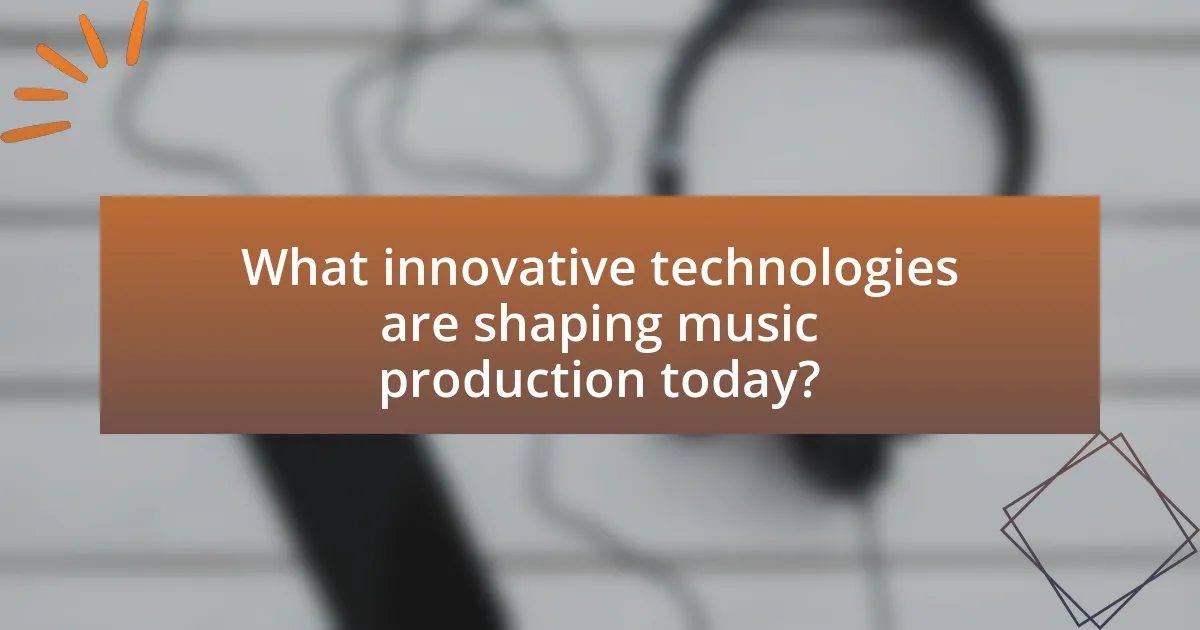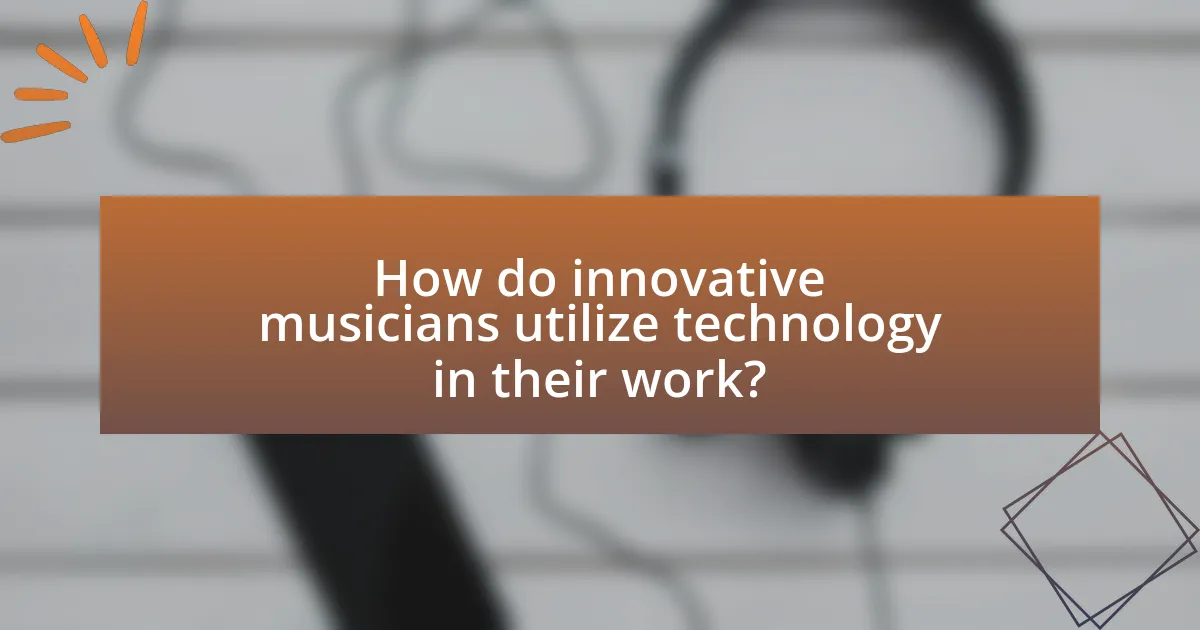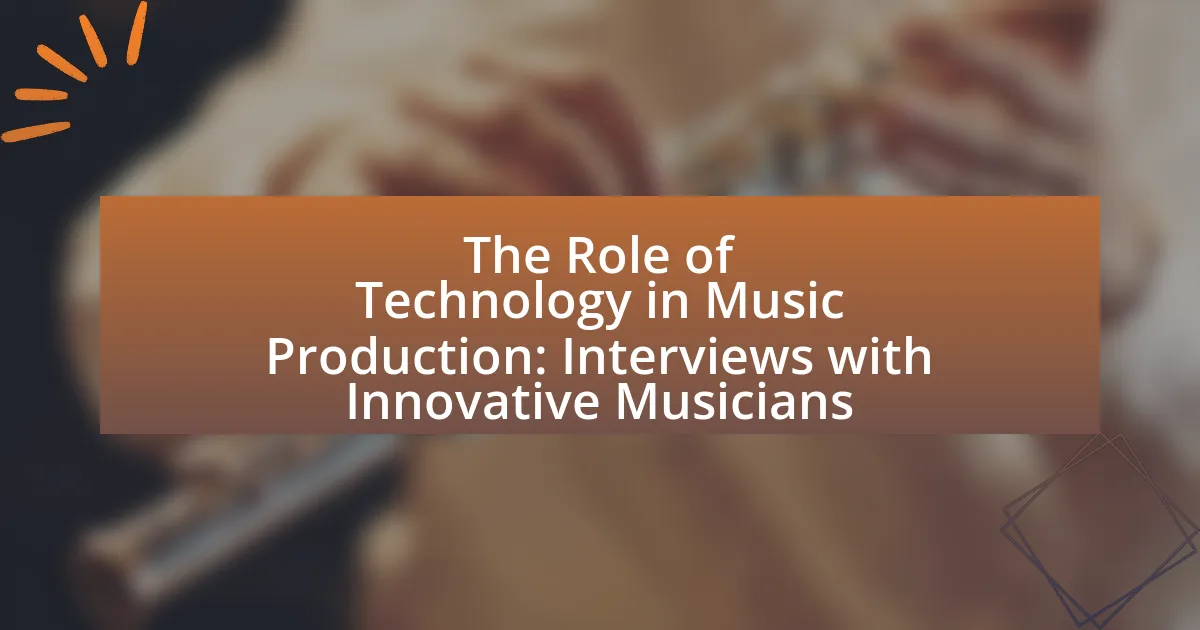The article examines the significant role of technology in music production, highlighting how digital tools have transformed the creative landscape for musicians. It discusses the impact of Digital Audio Workstations (DAWs), virtual instruments, and advanced audio plugins, emphasizing their contributions to accessibility, efficiency, and collaboration in music creation. Key insights from innovative musicians reveal how technology enhances their creative processes, influences songwriting, and facilitates remote collaboration. Additionally, the article addresses challenges musicians face without technology and dispels common misconceptions about its use in music production.

What is the Role of Technology in Music Production?
Technology plays a crucial role in music production by enabling artists to create, edit, and distribute music more efficiently and creatively. Digital Audio Workstations (DAWs) like Ableton Live and Pro Tools allow musicians to record, manipulate, and mix audio tracks with precision. Additionally, advancements in software plugins and virtual instruments provide a vast array of sounds and effects, enhancing the creative possibilities for producers. According to a report by the International Federation of the Phonographic Industry (IFPI), over 70% of music is now produced using digital technology, highlighting its dominance in the industry. This integration of technology not only streamlines the production process but also democratizes music creation, allowing independent artists to produce high-quality music without the need for expensive studio time.
How has technology transformed the music production landscape?
Technology has transformed the music production landscape by enabling unprecedented accessibility and efficiency in creating, recording, and distributing music. Digital audio workstations (DAWs) like Ableton Live and Pro Tools allow musicians to produce high-quality recordings from home studios, reducing the need for expensive studio time. Additionally, advancements in software plugins and virtual instruments have expanded creative possibilities, allowing artists to experiment with diverse sounds and effects. According to a report by the International Federation of the Phonographic Industry (IFPI), over 70% of music creators now utilize digital tools for production, highlighting the shift towards technology-driven processes in the industry.
What are the key technological advancements in music production?
Key technological advancements in music production include digital audio workstations (DAWs), virtual instruments, and advanced audio plugins. Digital audio workstations, such as Ableton Live and Pro Tools, revolutionized music production by allowing musicians to record, edit, and mix audio on computers, significantly reducing the need for traditional recording studios. Virtual instruments, like Native Instruments’ Kontakt, provide realistic sounds and expand creative possibilities without the need for physical instruments. Advanced audio plugins, including effects and mastering tools, enhance sound quality and offer greater control over the mixing process. These advancements have democratized music production, enabling independent artists to produce high-quality music from home studios.
How do these advancements influence the creative process?
Advancements in technology significantly influence the creative process in music production by providing musicians with innovative tools and platforms that enhance their artistic expression. For instance, digital audio workstations (DAWs) allow for greater flexibility in composing, recording, and editing music, enabling artists to experiment with sounds and arrangements more freely. Additionally, advancements in artificial intelligence can assist in generating new musical ideas or automating repetitive tasks, thereby allowing musicians to focus more on the creative aspects of their work. Research indicates that musicians who utilize technology report increased productivity and creativity, as they can access a wider range of sounds and production techniques than ever before.
Why is technology essential for modern musicians?
Technology is essential for modern musicians because it enhances creativity, streamlines production processes, and expands distribution channels. The integration of digital audio workstations, software instruments, and online platforms allows musicians to create high-quality music from virtually anywhere. For instance, a 2021 report by the International Federation of the Phonographic Industry noted that over 70% of music is now produced using digital technology, highlighting its prevalence in the industry. Additionally, technology enables musicians to reach global audiences through streaming services, which accounted for 62% of the global recorded music revenue in 2020, demonstrating its critical role in modern music distribution.
What challenges do musicians face without technology?
Musicians face significant challenges without technology, including limited access to distribution channels and reduced production quality. Without technology, musicians struggle to reach wider audiences, as traditional methods of distribution, such as physical media and live performances, are less effective in today’s digital age. Additionally, the absence of digital tools restricts their ability to produce high-quality recordings, as technology enables sophisticated editing, mixing, and mastering processes that enhance sound quality. Historical data shows that the rise of digital platforms has transformed the music industry, with over 60% of music consumption now occurring through streaming services, highlighting the necessity of technology for modern musicians to thrive.
How does technology enhance collaboration among musicians?
Technology enhances collaboration among musicians by providing tools that facilitate real-time communication, file sharing, and remote recording. Digital audio workstations (DAWs) like Ableton Live and Pro Tools allow multiple musicians to work on the same project simultaneously, regardless of their physical location. For instance, platforms such as Splice and Soundtrap enable musicians to share samples and collaborate on tracks in a cloud-based environment, streamlining the creative process. Additionally, video conferencing tools like Zoom and collaboration apps like Slack allow for instant feedback and brainstorming sessions, which can lead to more innovative musical ideas. These technological advancements have transformed traditional collaboration methods, making it easier for artists to connect and create together across distances.

What innovative technologies are shaping music production today?
Innovative technologies shaping music production today include artificial intelligence, cloud-based collaboration tools, and advanced digital audio workstations (DAWs). Artificial intelligence is revolutionizing music creation by enabling algorithms to compose, arrange, and even mix tracks, as seen in platforms like AIVA and Amper Music. Cloud-based collaboration tools, such as Splice and Soundtrap, allow musicians to work together in real-time from different locations, enhancing creativity and efficiency. Advanced DAWs, like Ableton Live and Logic Pro X, incorporate features such as MIDI manipulation and real-time audio processing, which streamline the production process and expand creative possibilities. These technologies collectively enhance the efficiency, accessibility, and creativity of music production.
How do digital audio workstations (DAWs) impact music creation?
Digital audio workstations (DAWs) significantly impact music creation by providing musicians with comprehensive tools for recording, editing, and producing music. DAWs enable users to manipulate audio tracks with precision, allowing for complex arrangements and sound design that were previously difficult or impossible to achieve with traditional recording methods. For instance, DAWs like Ableton Live and Pro Tools offer features such as MIDI sequencing, virtual instruments, and real-time effects processing, which enhance creative possibilities. The accessibility of DAWs has democratized music production, allowing a broader range of artists to create high-quality music from home studios, as evidenced by the rise of independent musicians who leverage these platforms to distribute their work globally.
What features of DAWs are most beneficial for musicians?
The most beneficial features of Digital Audio Workstations (DAWs) for musicians include multi-track recording, MIDI support, and a variety of built-in effects and virtual instruments. Multi-track recording allows musicians to layer different audio tracks, facilitating complex arrangements and enhancing creativity. MIDI support enables the use of virtual instruments and allows for precise control over musical elements, making it easier to compose and edit music. Additionally, built-in effects such as reverb, compression, and equalization provide musicians with tools to shape their sound without needing external plugins. These features collectively streamline the music production process, making it more efficient and accessible for musicians.
How do musicians choose the right DAW for their needs?
Musicians choose the right Digital Audio Workstation (DAW) by assessing their specific production needs, workflow preferences, and the features offered by different DAWs. They consider factors such as the type of music they create, the instruments they use, and their familiarity with software interfaces. For instance, a musician focused on electronic music may prefer a DAW with robust MIDI capabilities and virtual instruments, while a recording artist might prioritize audio editing features and compatibility with hardware. Additionally, musicians often rely on user reviews, tutorials, and trial versions to evaluate how well a DAW aligns with their creative process, ensuring it enhances rather than hinders their productivity.
What role do plugins and virtual instruments play in production?
Plugins and virtual instruments are essential tools in music production, enabling musicians and producers to create, manipulate, and enhance sound. They provide a wide range of sounds and effects that can be integrated into digital audio workstations (DAWs), allowing for greater creativity and flexibility in the production process. For instance, virtual instruments can simulate real instruments or create entirely new sounds, while plugins can apply effects such as reverb, compression, and equalization to enhance audio quality. The use of these technologies has revolutionized music production, making it more accessible and diverse, as evidenced by the fact that over 90% of music produced today utilizes some form of digital plugin or virtual instrument.
How do plugins enhance sound design and mixing?
Plugins enhance sound design and mixing by providing a wide range of tools that allow for precise audio manipulation and creative effects. These software components enable musicians and producers to apply equalization, compression, reverb, and other effects that shape the tonal quality and spatial characteristics of sound. For instance, equalizers can adjust frequency balance, while compressors control dynamic range, both of which are essential for achieving a polished mix. Additionally, plugins often include advanced features like virtual instruments and sound libraries, which expand the sonic palette available to creators. The integration of plugins into digital audio workstations (DAWs) streamlines the workflow, allowing for real-time adjustments and experimentation, which is crucial in modern music production.
What are the most popular virtual instruments among musicians?
The most popular virtual instruments among musicians include Native Instruments Kontakt, Spectrasonics Omnisphere, and EastWest Play. These instruments are widely used due to their extensive libraries and high-quality sound production capabilities. For instance, Native Instruments Kontakt is known for its versatility and has over 55,000 sounds available, making it a staple in many studios. Spectrasonics Omnisphere offers a vast range of synthesized sounds and is favored for its unique sound design features. EastWest Play provides access to a comprehensive collection of orchestral and cinematic sounds, appealing to composers and producers alike. These instruments are frequently mentioned in industry discussions and reviews, highlighting their significance in modern music production.

How do innovative musicians utilize technology in their work?
Innovative musicians utilize technology by integrating digital tools and software into their creative processes to enhance music production and distribution. They employ digital audio workstations (DAWs) like Ableton Live and Logic Pro to compose, record, and edit music, allowing for greater flexibility and experimentation. Additionally, they use software synthesizers and plugins to create unique sounds, which expands their sonic palette.
Furthermore, innovative musicians leverage social media platforms and streaming services for distribution and audience engagement, enabling them to reach global audiences without traditional gatekeepers. For instance, artists like Billie Eilish have successfully utilized platforms like SoundCloud and Spotify to launch their careers, demonstrating the effectiveness of technology in modern music promotion.
The incorporation of technology not only streamlines the production process but also fosters collaboration across distances, as musicians can work together in real-time using cloud-based tools. This technological integration has fundamentally transformed how music is created, shared, and consumed in the contemporary landscape.
What insights do musicians share about their creative processes?
Musicians share that their creative processes often involve a blend of inspiration, experimentation, and collaboration. Many emphasize the importance of technology, such as digital audio workstations and software instruments, which facilitate new sounds and ideas. For instance, artists like Imogen Heap have highlighted how technology allows for real-time manipulation of sound, enhancing their creative expression. Additionally, musicians often discuss the role of collaboration in their processes, noting that working with others can lead to unexpected directions and innovations in their music. This collaborative aspect is supported by studies indicating that diverse input can significantly enhance creativity in artistic endeavors.
How do musicians integrate technology into their songwriting?
Musicians integrate technology into their songwriting by utilizing digital audio workstations (DAWs), software instruments, and online collaboration tools. DAWs like Ableton Live and Logic Pro allow artists to compose, record, and edit music efficiently, enabling them to experiment with sounds and arrangements in real-time. Additionally, software instruments provide a vast array of sounds that can be manipulated, enhancing creativity. Online platforms such as Splice and Soundtrap facilitate collaboration among musicians across different locations, allowing for the sharing of ideas and resources instantly. This integration of technology not only streamlines the songwriting process but also expands the creative possibilities available to musicians.
What unique techniques do innovative musicians employ with technology?
Innovative musicians employ techniques such as live looping, algorithmic composition, and interactive performance systems to enhance their music creation process. Live looping allows musicians to layer sounds in real-time, creating complex compositions from simple phrases, as demonstrated by artists like Ed Sheeran. Algorithmic composition utilizes software to generate music based on predefined rules, enabling unique soundscapes, a method popularized by composers like Brian Eno. Interactive performance systems, which respond to audience input or environmental factors, create dynamic experiences, exemplified by projects like Imogen Heap’s “Mi.Mu” gloves that allow gesture-based control of sound. These techniques illustrate how technology expands creative possibilities in music production.
What challenges do musicians encounter when using technology?
Musicians encounter several challenges when using technology, including the complexity of software, the need for constant updates, and the potential for technical failures. The complexity of digital audio workstations (DAWs) can overwhelm musicians, especially those who are not tech-savvy, leading to a steep learning curve. Additionally, software updates can disrupt workflows, as new versions may introduce bugs or change familiar features. Technical failures, such as hardware malfunctions or software crashes, can result in lost work and frustration, impacting the creative process. These challenges highlight the necessity for musicians to balance their artistic skills with technological proficiency to effectively navigate modern music production.
How do musicians overcome technical difficulties in production?
Musicians overcome technical difficulties in production by utilizing a combination of problem-solving skills, collaboration, and technology. They often troubleshoot issues in real-time, employing software tools to diagnose and fix problems, such as using digital audio workstations (DAWs) that provide visual feedback on audio signals. Collaboration with sound engineers and other musicians allows for shared expertise, which can lead to innovative solutions. Additionally, many musicians invest time in learning about the technology they use, which enhances their ability to navigate challenges effectively. For instance, a study by the Berklee College of Music found that musicians who are proficient in their production tools are 30% more likely to complete projects on time, demonstrating the importance of technical knowledge in overcoming production hurdles.
What common misconceptions exist about technology in music production?
Common misconceptions about technology in music production include the belief that technology can replace human creativity and that high-quality music requires expensive equipment. Many people think that software and hardware can create music independently, undermining the essential role of the artist’s vision and creativity in the process. Additionally, while professional-grade tools can enhance production quality, numerous successful tracks have been produced using affordable or even free software, demonstrating that creativity and skill are more critical than the price of the tools used.
What best practices can musicians adopt for effective technology use?
Musicians can adopt several best practices for effective technology use, including staying updated on software and hardware advancements, utilizing digital audio workstations (DAWs) efficiently, and integrating collaboration tools for remote work. Staying current with technology allows musicians to leverage new features that enhance creativity and productivity; for instance, the adoption of cloud-based platforms has increased collaboration opportunities, as evidenced by the rise of remote music production during the COVID-19 pandemic. Efficient use of DAWs, such as Pro Tools or Ableton Live, enables musicians to streamline their workflow, allowing for quicker editing and mixing processes. Additionally, utilizing collaboration tools like Splice or Soundtrap facilitates seamless sharing and feedback, which is crucial in modern music production.
